Key Points
- Intact female guinea pigs are “sows” and intact males are “boars”.
- Mature boars have distinct scrotal pouches and large testes.
- Male guinea pigs have several accessory sex glands, including large, paired seminal vesicles or vesicular glands, which can be mistaken for uterine horns.
- Puberty occurs at approximately 2 months in females and between 2-3 months in males.
- The pubic symphysis separates in the last days of pregnancy.
- Separation of the pubic symphysis may be inadequate in sows bred after 7-8 months of age and dystocia can result in these individuals. Other potential causes of dystocia include obesity and large fetal size.
- Sows often give birth to 2-4 large, precocial pups. Other rodent species generally have large litters.
- Pregnancy toxemia is an important cause of perinatal mortality in guinea pigs. This condition is most often observed in primiparous, obese sows in late gestation. The prognosis is often guarded. Minimize the risk of pregnancy toxemia by encouraging exercise, preventing obesity, and minimizing stress in the pregnant sow.
- Unilateral or bilateral ovarian cysts are very common, particularly in older sows.
- Ovariohysterectomy or ovariectomy is recommended to prevent the development of ovarian cysts and other reproductive problems in non-breeding companion sows.
Introduction
The guinea pig (Cavia porcellus) is a popular companion animal and a common research model. Guinea pigs are useful in reproductive studies because they share many reproductive traits with human beings (Fig 1).26 Like humans, guinea pigs possess a hemochorial placenta, in which maternal blood comes in direct contact with the fetal chorion, as well as similar trophoblast invasion patterns and comparable uterine vasculature.20,23,26 The guinea pig’s gestation period can also be divided into trimesters, analogous to the human condition.26 Of course, some features of guinea pig reproductive anatomy and physiology are shared with other members of Order Rodentia, and other features are unique to this special species. This article reviews anatomy and physiology of the guinea pig reproductive tract and summarizes some clinically significant medical problems.
Boars
Intact male guinea pigs, or “boars”, enter puberty between 70-90 days, however males begin to show sexual behavior, such as mounting, at 1 month of age.9,17,23 At 2 months, boars begin to ejaculate while mounting.23 Expression of sexual behavior and physical development is significantly suppressed if the boar is housed with its mother and/or siblings.11
Boars tend to be larger than females, with both sexes having a single pair of inguinal mammae.5 Mature boars possess large, paired testes, which are located on either side of the perineum in distinct, shallow scrotal sacs (Fig 2).5,9,23 The testicles are usually fully descended into the scrotum by 81 days.2 If the testes have not descended by 4 months of age, the guinea pig should be considered cryptorchid.9 The inguinal canals remain open for life.9,19 To prevent herniation post-castration, many clinicians utilize a closed technique or a modified open technique, where the tunica is included in the suture that is used to tie off the spermatic cord and vessels.32

Figure 2. Gross image of the testicle (arrow) in a mature boar (Cavia porcellus). The epididymis lies along the dorsolateral surface of the testis. The tail of the epididymis gives rise to the ductus deferens. Credit: Drury Reavill, DVM, DABVP (Avian Practice), DACVP. Click image to enlarge.
Clinical Tip: Although large, paired testes are obvious in mature boars, gender identification can be challenging in young pups. If the testicles are not obvious, sexing can be facilitated by placing gentle pressure at the base of the prepuce to partially extrude the penis.23
The S-shaped penis consists of a body and glans. Guinea pigs possess an os penis, which is found within the dorsal surface of the entire length of the glans.9,19 Like other hystricomorph rodents, the penis also has minute, saw-toothed white spurs arranged dorsolaterally in two parallel lines from the urethral orifice to the glans. There is also an intromittent sac on the ventral surface of the glans penis.9 During erection, the sac everts and two horny styles protrude.5,9,23 The function of these 3-5 mm long projections is unknown.9
Male reproductive glands include the seminal vesicles (vesicular glands), coagulating glands, bulbourethral glands, and the prostate (Fig 3).5,27 A rudimentary preputial gland may also be present in the boar.9

Figure 3. Reproductive anatomy of the guinea pig (Cavia porcellus) boar. (A) seminal vesicle (B) testis C) vas deferens (D) anterior prostate gland or coagulating gland (E) urinary bladder (F) Cowper’s or bulbourethral gland (G) urethra (H) penis (I) epididymis. Photo credit: Drs. Craig Franklin and Cindy Besch-Williford. Click image to enlarge.
- The large, transparent, smooth seminal vesicles are the largest reproductive glands of the boar, measuring up to 100 mm in length and 6-9 mm in diameter. These long, coiled, paired blind sacs lie ventral to the ureters and enter the urethra by a pair of ducts immediately caudodorsal to the ductus deferens.9,19,23,27
Clinical Tip: The large, paired seminal vesicles can be mistaken for uterine horns.
- The prostate gland consists of two pairs of lobes. A small ventral lobe and a large dorsal lobe are connected by a transverse isthmus, which lies caudomedial to the coagulating glands and lateral to the base of the seminal vesicles.9,27
- Paired coagulating glands are cone-shaped and lobulated. They lie near the seminal vesicles, caudal to the urinary bladder, and are closely associated with the prostate.9
- Paired bulbourethral glands are small, lobulated, oval masses connected to the urethra by a single duct.9
Each hair follicle of the guinea pig is associated with an androgen-dependent sebaceous gland. These glands are abundant along the back and are also found around the anus, where they are called the caudal gland or “grease gland”.9,23 The caudal gland is more developed in the boar and is used for scent marking (Fig 4). Boars frequently rub or press their rump against a surface, and the secretions deposited serve as a sexual attractant and to mark territory.9,23
Figure 4. Caudal gland (large arrow) and perineum (small arrow) in a male guinea pig (Cavia porcellus). Source: Uwe Gille via Wikimedia Commons. Click image to enlarge.
Sows
Puberty occurs around 2 months of age in the female guinea pig or “sow”.23 Peak reproduction is observed between 3-4 to 20 months and reproduction may continue until 4-5 years of age.19,23 Guinea pigs are seasonally polyestrous and breed year-round in captivity.9,23 Sows are spontaneous ovulators, with an estrous cycle between 15-17 days (range 13-21 days).19 Sows exhibit distinct signs of proestrus and estrus. During proestrus, sows become more active, chasing cage mates around, swaying their hindquarters, and producing a distinct guttural sound. Estrus lasts 6-11 hours, and during this time the sow displays lordosis, curvature of the spine with elevated hips, as well as vulvar dilation.23
The sow possesses a single pair of inguinal mammary glands with a single pair of inguinal mammary nipples (Fig 5), however supernumerary nipples are common.9,19,22 When compared to the boar, the sow’s nipples are longer and more prominent.9
Figure 5. Both male and female guinea pigs (Cavia porcellus) possess a single pair of inguinal mammary glands. Source: Drury Reavill, DVM, DABVP (Avian Practice), DACVP. Click image to enlarge.
Sows possess paired ovaries and a bicornuate uterus, consisting of paired uterine horns, a short uterine body, and a single os cervix (Fig 6, Fig 7).5,9,23
Figure 6. View of one uterine horn (arrow) in mature guinea pig (Cavia porcellus). Source: Drury Reavill, DVM, DABVP (Avian Practice), DACVP Click image to enlarge.
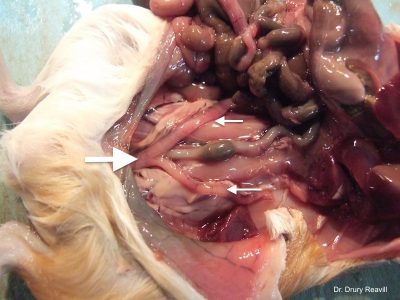
Figure 7. Gross view of the uterine horns (small arrows) and body (large arrow) in a guinea pig (Cavia porcellus). Source: Drury Reavill, DVM, DABVP (Avian Practice), DACVP. Click image to enlarge.
During anestrus and pregnancy, the vaginal opening in hystricomorph rodents is sealed with an epithelial membrane called the vaginal closure membrane. The membrane opens at estrus, Day 26 or 27 of gestation, and at parturition in many animals.19,22,23,29 The sow has a Y-shaped depression in perineal tissues. The vulvar opening lies at the intersection of the branches and the anus is located at the base of the Y (Fig 8).23

Figure 8. Y-shaped depression in the perineum of a guinea pig sow (Cavia porcellus), illustrating the vulva (white arrow) and the anus (yellow arrow). Source: Dorcas O’Rourke, DVM, MS, DACLAM. Click image to enlarge.
Copulation
When a receptive female is introduced, the boar begins to purr and sway his posterior from side to side, while circling, and sometimes brushing against the sow or even spraying urine at the sow. If the female is unreceptive, aggressive male behavior may be observed such as barbering the hair on the female’s neck.19 A receptive female will allow the male to sniff and lick her anogenital region.6,11,19 She assumes the lordosis position and allows the male to mount her. Whether ejaculation occurs or not, the male will perform genital grooming by dragging his perineum along the cage floor. Meanwhile the female doubles over and uses her mouth to groom her genitals.19 Mating usually occurs in the dark.8
Copulation is confirmed by the presence of a firm, rubbery deposit within the vagina called the copulatory or vaginal plug, composed of a solid mass of ejaculatory fluid.23 There are several theories on the function of the copulatory plug in rodents, including sperm storage, prevention of sperm leakage, promotion of sperm transport, and/or to prevent later fertilization by other males.23 The copulatory plug falls out several hours after mating.23
Gestation
The average guinea pig pregnancy lasts 68 days, with a reported range of 59-72 days.9,19,23 These dates vary with strain, parity, and litter size.23 Average litter size is 2-4 pups with a range of 1-13 pups.23 Obvious abdominal distension is not observed until late gestation.8
Clinical Tip: Fetuses can be palpated as early as day 15 of gestation as firm, oval swellings, Fetuses are more evident by 28-35 days, and individual body parts may be palpable by day 35.8,9,23 See Kaufmann 2004 in Further Reading below for additional information on guinea pig palpation.
Parturition
The birth canal of the sow is narrow at the level of the os coxae 30, and impending parturition is signaled by separation of the pubic symphysis.9,23 The release of relaxin by the pituitary gland and endometrium results in complete dissolution of the fibrocartilage of the pubic symphysis.9,23,30 By Day 40, only a small cartilaginous bridge extends across the symphysis and by birth, no cartilage is present.9,23
Clinical Tip: A gap up to 15 mm in width can be palpated at the pubic symphysis approximately 2 days before birth. The width of this gap increases up to 25 mm or more at the time of parturition.23
Guinea pigs do not build nests 22,23, however sows have been shown to display interest in other young in the cage just before giving birth.19 Parturition can occur at any time of day. The sow will display a quadrupedal squat, similar to that of defecation, as she gives birth.19 Birth is typically a rapid process. There is only about 5 minutes from the start of parturition to the birth of the first pup and only 3-4 minutes between subsequent births (Video 1).5,19,23
Video 1. Guinea pig birth, with a pup expelled at time stamp 1:50
After a newborn is expelled from the birthing canal, the sow doubles over to grab the pup with her teeth, followed by licking of the newborn and ingestion of the fetal membranes.19 Both males and females assist in grooming pups at parturition.22 Young may be left unattended until the last pup is expelled.19
The placenta is expelled once the last young is born.19,23 Guinea pigs are completely herbivorous, with the exception of placentophagy, the act of eating the placenta.23 The sow, the boar, and other guinea pigs in the cage will all ingest the placenta.19,22,23 Cannibalism or consumption of aborted fetuses and stillborn pups has not been documented in the guinea pig.22
Postpartum estrus occurs approximately 2-10 hours after parturition.9,19 If bred, the sow will not begin to attend to her young again until after mating.19
Newborn guinea pigs
The birth weight of newborn guinea pigs, also known as “pups” or “young”, ranges from 45-115 grams.19,23 Body weight is inversely related to litter size, and young less than 60 grams rarely survive.23 The newborn guinea pig is precocial: born fully furred with open eyes.9,23 The pup is able to crawl within minutes, stand shortly after birth, and walk and groom itself within a day.5,23 Pups tend to follow their mother or sometimes other adult females within the cage.5 Vocal communication is important for mobile, precocial species and guinea pig pups produce distinct calls when separated from their mothers. Sows are able to use vocal cues in pup recognition.9,16
Guinea pig mothers are not particularly attentive 5,23, although mothers of large litters are more responsive to offspring for a longer period of time than females with smaller litters.15 Maternal grooming behavior is normally limited to anogenital licking for 2-3 weeks after parturition to assist the newborn with elimination of waste.19 Voluntary micturition and defecation develops during the second week of life.19,23
Paternal behavior in guinea pigs is not well studied, however, playing with pups and grooming the pups have been observed in wild boars.1 It has been shown that more paternal behavior is displayed when only one boar is present with a receptive female. Competition from other males and a drive to mate with multiple females presumably results in less time or interest in paternal behavior.1
Pups begin social play with littermates at about day 3. Play is most prominent at 3 weeks of age, and includes hopping vertically into the air, hopping while changing direction, and hopping with a shake of the head and a prancing gait (Video 2).19
Video 2. “Popcorning” behavior in a guinea pig pup.
Lactation
Guinea pig milk contains 3.9% fat, 8.1% protein and 3.0% lactose.19,23 The normal lactation period is approximately 3 weeks long.23,29 Milk production peaks at day 7 post-partum and regresses at 4-weeks postpartum.9 The number of pups often exceeds the number of mammary glands however the young normally encounter little trouble obtaining milk.19 If born into a cage with older pups that are still nursing, the neonate may be pushed off the teat and may not be able to nurse as often as required.19
While nursing, newborns display filial lordosis. The back is flat and the perineal region is raised to allow the mother to lick the anogenital region. Sometimes while displaying filial lordosis, the newborn creates a purr call, which is thought to be a type of contact call.19 This behavior decreases as pups develop voluntary micturition during the second week of life.19,23
Guinea pig mothers passively allow nursing, rather than actively seeking out their young.5,23 Lactating sows will also permit young from other females to nurse.5,23 Ideally, an orphaned pup should receive milk from a lactating sow for a minimum of 5 days.23 The pup rarely survives if it does not receive sow’s milk for the first 3-4 days of life,23 however the pup does receive all maternal antibody from the placenta.31
If fostering is not possible, orphaned guinea pigs can be fed from a dropper or pet nurser beginning at 12-24 hours after birth.23 A 1:1 mixture of evaporated milk and water has been used to approximate guinea pig milk.23 One feeding schedule that has been recommended is every 2 hours until Day 5, then every 4 hours thereafter.23 Stimulate the pups to eliminate after every feeding until the second week of life.23
In Australia, a guinea pig milk replacer is commercially available through Wombaroo.
Weaning
Although nursing continues for several weeks, pups begin nibbling on solids by Day 2 or within a few days of life.5,23 Pellets moistened with formula or water can be offered to the young.23 Pups are typically weaned at 21 days (range 14-28 days) or at a weight of 150-200 grams.5,19,23 Hand-raised pups can be successfully weaned at day 3-4 due to their precocious nature as long as anogenital stimulation is still provided.19,22 Pups remain near their mother and littermates well beyond weaning, although more time is spent with other adult females (but not males) after weaning.9,11
Pregnancy-associated diseases
Pregnancy toxemia
Pregnancy toxemia can occur during late gestation, usually 2 weeks prepartum to 2 weeks postpartum.7,10 There are two distinct forms of pregnancy toxemia although the clinical picture is similar for both.7 Common clinical signs include anorexia, depression, ataxia, and dyspnea, which can progress to muscle spasms, paralysis, and death.7,13
Fasting or metabolic toxemia, also known as pregnancy ketosis, is prevalent in obese sows, often during their first or second pregnancy.10 The heavy demand of the growing fetuses creates a negative energy balance and subsequent metabolism of fat.10,13 Laboratory findings include acidosis, hypoglycemia (< 60 mg/dL), hyperlipidemia, hyperkalemia, ketonuria, proteinuria, and aciduria, in which urinary pH falls from about 9 to 5-6.8,12,13,17,30 Manage ketosis with warm intravenous (IV) or intraosseous isotonic fluids with dextrose and oral glucose.10 Begin a high-fiber, nutrient dense food, like Emeraid Herbivore Intensive Care.17 The prognosis for pregnancy toxemia is poor and prevention is essential. Encourage exercise and prevent obesity while ensuring food and water is readily available.10,13,30 Minimize stress and avoid any changes in the diet or housing during late pregnancy.10
The circulatory form of pregnancy toxemia, also known as preeclampsia, is caused by ischemia of the placenta and uterus due to compression of the blood supply by the gravid uterus. The uterus can also compress blood supply to the kidneys or gastrointestinal tract.10 The fetuses are usually dead and decomposing.13 Evaluation of pregnancy-related ischemia relies upon indirect blood pressure measurement to look for hypertension, due to compression of the renal vessels, or hypotension caused by shock.10 Laboratory findings include proteinuria and elevated creatinine.17 Institute shock therapy for the hypotensive patient.10 Treatment of uteroplacental ischemia relies upon an emergency cesarean section and IV fluids with glucose,13 although this does carry significant clinical risk.
Dystocia
Sows suffer from a high rate of fetal deaths (stillbirths) and early neonatal deaths due to dystocia.7,23 Dystocia can develop if the first breeding is delayed until after the pubic symphysis has fused, if the pups are too large for the birthing canal, the birthing canal is abnormally small, or when the sow is obese.19,30 Suspect dystocia in gravid sows that show depression or a bloody or discolored vaginal discharge. An emergency cesarean section is indicated in most cases.23
Visit LafeberVet’s Dystocia in Guinea Pigs for additional information.
Other reproductive diseases
Ovarian cysts, mammary gland tumors, as well as uterine and cervical neoplasia are among the most common diseases reported in the sow. Other reproductive conditions described in the literature include vaginal or uterine prolapse, mastitis, pyometra, metritis, vaginitis, orchitis, and epididymitis.10,17
Ovarian cysts
Unilateral or bilateral ovarian cysts (cystic rete ovarii) are one of the most common reproductive diseases of the sow (Fig 9).10,24,25 Single or multilocular, serous cysts have been identified in 58% to 100% of sows between 3 months to 5 years of age.3,10,17,30 The size and prevalence of cysts increases with age.7,24
Figure 9. Gross image illustrating ovarian cysts in a guinea pig (Cavia porcellus). Credit: Drury Reavill, DVM, DABVP (Avian Practice), DACVP.
Ovarian cysts are often associated with other conditions, such as leiomyomas, granulosa cell tumors, cystic endometrial hyperplasia, mucometra, and endometritis.4,7,10,28 Clinical signs can include pear-shaped abdominal distension, anorexia, depression, and infertility.10,28 When functional follicular cysts are present, bilaterally symmetrical alopecia can also be found on the flanks due to hyperestrogenism.10,28 Behavioral changes, such as aggression or persistent estrus, can also be observed.28
Definitive diagnosis of ovarian cysts relies upon abdominal ultrasound or exploratory laparotomy, although survey radiographs can identify large cysts in many cases.7,10 The treatment of choice is ovariohysterectomy or ovariectomy as recurrence is common, however there is risk associated with anesthesia and surgery in these older, clinically ill patients.7,10,28 Hormonal therapy has not been shown to serve as an effective mode of treatment.10,24,28 Due to the high incidence of ovarian cysts and other breeding problems, elective ovariohysterectomy or ovariectomy is recommended in non-breeding animals.7
Neoplasia
Reproductive tumors account for approximately 25% of the neoplasms seen in guinea pigs 3 years of age or older.14,22 Reproductive tract tumors are more common in sows than boars, with mammary gland and uterine neoplasia most frequently reported.14,18,22 Testicular tumors are rare.14,30
- Mammary adenocarcinomas and fibroadenomas can occur in both boars and sows.14,21
- Reported uterine tumors include leiomyoma, leiomyosarcoma, fibroma, myxoid fibrosarcoma, and uterine spindle sarcoma.14,21,28,30
- Spontaneous ovarian tumors include teratomas, granulosa cell tumors, and adenocarcinomas.4,14,21,30
- Cervical polyps, as well as adenomas and adenocarcinomas of the cervix have also been described.18
Summary
Male guinea pigs possess distinct scrotal pouches and large testicles. Boars also have several accessory sex glands, including paired seminal vesicles or vesicular glands. These large, coiled, blind sacs are extremely large, filling a large portion of the caudal abdomen. Puberty occurs between 2-3 months in male guinea pigs and at 2 months in females. Sows are seasonally polyestrous and spontaneous ovulators. The average guinea pig pregnancy lasts 68 days, with a reported range of 59-72 days. During gestation, the cartilage joining the bones of pubic symphysis begins to dissolve and is completely gone by birth. This separation of the pubic symphysis may be inadequate in primiparous sows bred after 7-8 months and dystocia may result. Additional important reproductive diseases include pregnancy toxemia and ovarian cysts. Neonatal guinea pigs are precocial. Guinea pig mothers allow passive nursing and young from other females are able to nurse, which makes fostering a viable possibility for the orphaned pup.
References
References
1. Adrian O, Brockmann I, Hohoff C, Sachser N. Paternal behaviour in wild guinea pigs: a comparative study in three closely related species with different social and mating systems. J Zool:265(1):97–105, 2005.
2. Atkinson PM. The effects of early experimental cryptorchidism and subsequent orchidopexy on the maturation of the guinea-pig testicle. Br J Surg 60(4):253-258, 1973.
3. Bean AD. Ovarian cysts in the guinea pig. Vet Clin North Am Exot Anim Pract 16(3):757-776, 2013.
4. Burns RP, Paul-Murphy J, Sicard GK. Granulosa cell tumor in a guinea pig. J Am Vet Med Assoc 218(5):726-728, 2001.
5. Clemons DJ, Seeman JL. The Laboratory Guinea Pig. Boca Raton, FL: CRC Press Taylor & Francis; 2011.
6. Cohn DWH, Tokumaru RS, Ades C. Female novelty and the courtship behavior of male guinea pigs (Cavia porcellus). Braz J Med Biol Res 37(6):847-851, 2004.
7. Donnelly TM, Brown CJ. Guinea pig and chinchilla care and husbandry. Vet Clin North Am Exot Anim Pract 7(2):351-373, 2004.
8. Gresham VC, Haines VL. Management, husbandry, and colony health. In: Suckow MA, Stevens KA, Wilson RP (eds). The Laboratory Rabbit, Guinea Pig, Hamster, and Other Rodents. Boston, MA: Academic Press; 2012: 611-612, 614.
9. Hargaden M, Singer L. Anatomy, physiology, and behavior. In: Suckow MA, Stevens KA, Wilson RP (eds). The Laboratory Rabbit, Guinea Pig, Hamster, and Other Rodents. San Diego, CA: Elsevier Academic Press; 2012: 576, 590-596, 599.
10. Hawkins MG, Bishop CR. Disease problems of guinea pigs. In: Quesenberry KE, Carpenter JW (eds). Ferrets, Rabbits, and Rodents: Clinical Medicine and Surgery, 3rd ed. St. Louis, MO: Elsevier Saunders; 2012: 301-303.
11. Hennessy MB, Reed J, Wilson SE, Pitstick L. Sexual interactions of maturing male guinea pigs with their mothers, sisters, and unfamiliar adult females in the home cage. Dev Psychobiol 42(1):91–96, 2003.
12. Johnson J. Guinea pig medicine primer. Annu Conf Atlantic Coast Veterinary Conference 2006.
13. Johnson-Delaney CA. Urogenital tract problems in small mammals. Annu Conf Wild West Veterinary Conference 2011.
14. Kharbush RJ, Renee VR, Howard S, Sladky KK. Surgical resection of a testicular seminoma in a guinea pig (Cavia porcellus). J Exotic Pet Med 26(1):53-56, 2017.
15. Kober M, Trillmich F, Naguib M. Vocal mother-offspring communication in guinea pigs: females adjust maternal responsiveness to litter size. Front Zool 5:13, 2008.
16. Kober M, Trillmich F, Naguib M. Vocal mother-pup communication in guinea pigs: effects of call familiarity and female reproductive state. Anim Behav 73(5):917-925, 2007.
17. Kondert L, Mayer J. Reproductive medicine in guinea pigs, chinchillas and degus. Vet Clin North Am Exot Anim Pract 20(2):609-628, 2017.
18. Laik-Schandelmaier C, Klopfleisch R, Schöniger S, et al. Spontaneously arising tumours and tumour-like lesions of the cervix and uterus in 83 pet guinea pigs (Cavia porcellus). J Comp Pathol 156(4):339-351, 2017.
19. Shomer NH, Holcombe H, Harkness JE. Biology and diseases of guinea pigs. In: Fox JG, Anderson LC, Otto GM, et al (eds). Laboratory Animal Medicine, 3rd ed. San Diego, CA: Academic Press Elsevier; 2015:252-253.
20. Mess A. The guinea pig placenta: model of placental growth dynamics. Placenta 28(8-9):812-815, 2007.
21. Minarikova A, Hauptman K, Jeklova E, et al. Diseases in pet guinea pigs: a retrospective study in 1000 animals. Vet Rec 177(8):200, 2015.
22. Percy DH, Barthold SW. Guinea pig. In: Barthold SW, Driffey SM, Percy DH (eds). Pathology of Laboratory Rodents and Rabbits (3rd ed). Ames, IA: Blackwell Publishing; 2007: 213-214, 216-251.
23. Quesenberry KE, Donnelly TM, Mans C. Biology, husbandry, and clinical techniques of guinea pigs and chinchillas. In: Quesenberry KE, Carpenter JW (eds). Ferrets, Rabbits, and Rodents: Clinical Medicine and Surgery, 3rd ed. St. Louis, MO: Elsevier Saunders; 2012: 280-283.
24. Schuetzenhofer G, Goericke-Pesch S, Wehrend A. Effects of deslorelin implants on ovarian cysts in guinea pigs. Scweiz Arch Tierheilkd 153(9):416-417, 2011.
25. Sommerey CC, Köhler K, Reinacher M. Diseases of guinea pigs from the perspective of pathology. Tierärztl. Prax. 32:377, 2004.
26. Taylor DK, Lee VK. Guinea pigs as experimental models. In: Suckow MA, Stevens KA, Wilson RP (eds). The Laboratory Rabbit, Guinea Pig, Hamster, and Other Rodents. Boston, MA: Academic Press; 2012: 709.
27. Váquez B. Morphologic study of the prostate and vesicular glands of the guinea pig (Cavia porcellus). International Journal of Morphology 28:1301-1307, 2010.
28. Veiga-Parga T, La Perle KM, Newman SJ. Spontaneous reproductive pathology in female guinea pigs. J Vet Diagn Invest 28(6):656-661, 2016.
29. Weir BJ. Reproductive characteristics of hystricomorph rodents. In: Rowlands JW, Weir BJ (eds). The Biology of Hystricomorph Rodents. London: Zoological Society of London; 1974: 265-301.
30. Williams BH. Non-infectious diseases. In: Suckow MA, Stevens KA, Wilson RP (eds). The Laboratory Rabbit, Guinea Pig, Hamster, and Other Rodents. Boston, MA: Academic Press; 2012: 693-695.
31. Harkness JE, Turner PV, VandeWoude S, Wheler CL. The guinea pig. In: Harkness JE, Turner PV, VandeWoude S, Wheler CL (eds). Harkness and Wagner’s Biology and Medicine of Rabbits and Rodents, 5th ed. Ames, IA: Wiley-Blackwell; 2010: 55.
32. Brower M. Practitioner’s guide to pocket pet and rabbit theriogenology. Theriogenology, 66(3): 618-623, 2006.
Further reading
Banks R. The guinea pig: Biology, care, identification, nomenclature, breeding, and genetics. Feb 17, 1989. USAMRIID Seminar Series. Accessed Oct 20, 2017. Available at http://netvet.wustl.edu/species/guinea/guinpig.txt.
Cooper G, Schiller AL. Anatomy of the Guinea Pig. Cambridge, MA: Harvard University Press; 1975.
Kaufmann P. Guinea pig. 2004. University of California San Diego Comparative Placentation. Accessed Oct 20, 2017. Available at http://placentation.ucsd.edu/guinea.htm.
Laik-Schandelmaier C, Marschang RE, Klopfleisch R, et al. Gynecological tumors in guinea pigs. Proc International Conference on Avian Herptelogical and Exotic Mammal Medicine 2017: 809-810.
Seidl DC, Hughes HC, Bertolet R, Lang CM. True pregnancy toxemia (preeclampsia) in the guinea pig (Cavia porcellus). Lab Anim Sci 29(4):472-478, 1979.
Turner AJ, Trudinger BJ. Ultrasound measurement of biparietal diameter and umbilical artery blood flow in the normal fetal guinea pig. Comp Med 50(4):379-384, 2000.
Pollock C, Arbona N. Guinea pig reproduction basics. Nov 12, 2017. LafeberVet Web site. Available at https://lafeber.com/vet/guinea-pig-reproduction-basics/
